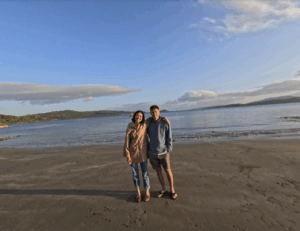Exploring Scotland’s Wild Wonders – A Visit with the Highlands and Islands Environment Foundation
By Sekoah, Partnerships Executive at Conservation Collective
Day 1: From the City Hums to Highland Green
Leaving behind the constant hum of London, I boarded a train heading north to Edinburgh. With every mile, the landscape softened and opened up. By the time I stepped off the train, the air smelt different—cooler, greener. There, I met Louis, the Project Coordinator at the Highlands and Islands Environment Foundation (HIEF), and we set off together, making our way past Scotland’s Central Belt and steadily climbing into the rugged terrain of the Highlands.
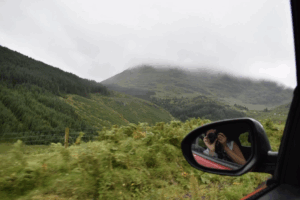
The scenery was staggering, vibrant green rolling hills drenched in mist and history, seemingly untouched and eternal. But beneath the surface beauty lies a fragile ecology, Louis explained. He pointed out how deforestation was biting into the landscape. Deer, unchecked by natural predators, graze ancient roots into extinction. In the 1700s the influx of sheep farming and game hunting dramatically reshaped the land, stripping it of wildflowers and preventing woodland recovery. A quiet conversation emerged about the reintroduction of lynx—a native predator that could help balance deer numbers—but political resistance remains, especially from farming communities.
It’s easy to confuse green with healthy. Scotland’s dramatic scenery is globally admired, but in reality only about 4% of Scotland’s land area is covered by native woodland — that is, forests made up of tree species that are naturally found in Scotland (e.g. Scots pine, birch, oak, hazel). As George Monbiot writes in Feral, much of the Scottish landscape is “a bare, bleak green desert,” visually lush, yet ecologically hollow. We’ve become so accustomed to this state of decline that we no longer see it. It’s what some now call ecological blindness—when beauty masks the true condition of the land.
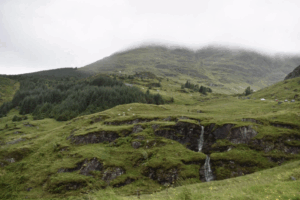
We paused our journey for a wild swim along the coast. Seaweed brushed my toes, and the cold water turned into a burn—a shock that made me feel more alive than I have in weeks. A rare sighting of two otters playing in the distance, and a curious seal bobbed near us. That simple swim—wild and connected—set the tone for the rest of the journey.
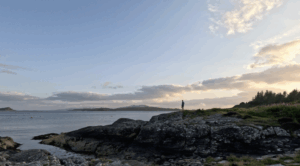
Day 2: Two Visions of Regeneration in Oban
The next morning, we met up with Sally, Executive Director of HIEF, and members of the Foundation’s Steering Committee—a passionate group of supporters who are the driving force behind HIEF’s impactful work. Remarkably, the day was sunny—a rare treat in Scotland. Laura, one of the SC members, cheerfully taught me with a local proverb: “Rain before seven, fine by eleven.” The day was packed with field visits to two projects supported by HIEF.
Our first visit took us to a transformative woodland restoration project by Keep Oban Beautiful nestled beside a local high school. This site was an overlooked strip of council-owned land —choked by invasive species and used as an informal dump for everything from mattresses to scrap metal. But hidden in the undergrowth were rare oceanic bryophytes and lichens—species that revealed the site to be a remnant of Scotland’s rare temperate rainforest. Recognising this ecological treasure, Laura from Keep Oban Beautiful set out to restore and reimagine the site with support from a grant from the HIEF.
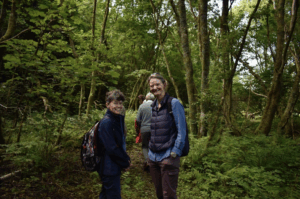
Laura guided us through the woodland, our footsteps were muffled by damp leafy underfoot, and the air was thick with humidity. Light filtered through the leaves of Scots pine, willow, and birch. Teal lichens glowed against tree trunks, sculptures by local artists emerged unexpectedly from the undergrowth, and a waterfall nearby filled the space with sound and stillness.
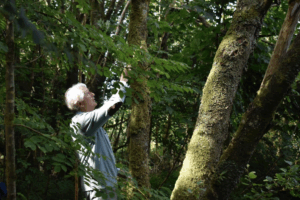
Laura welcomed us with tea brewed in the woods and recounted her team’s ongoing battle with invasive rhododendron, clearing it to make way for the slow return of native species. Volunteers are replanting the area with native trees and a new wetland is being designed on the fringe of the woodland.
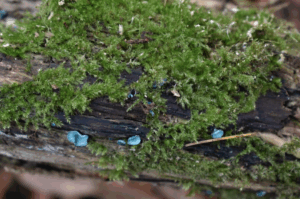
A boardwalk will improve accessibility to the site while guiding visitors into this rich and varied ecosystem. Educational features like QR codes, wildlife boxes, and interpretive signage will further enhance the woodland experience—inviting local schoolchildren, dog walkers, and tourists alike to slow down, observe, and reconnect.
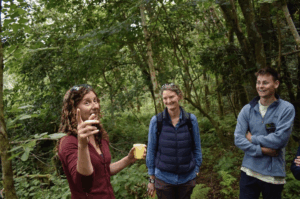
Laura explained that in other parts of Scotland, rewilding has already welcomed back red squirrels and pine martens—and she hopes this woodland, too will see their return.
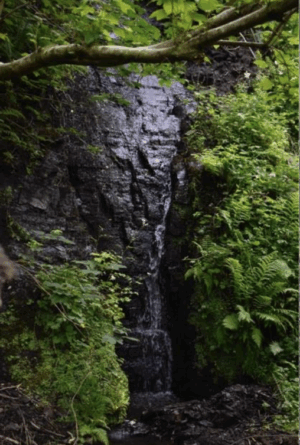
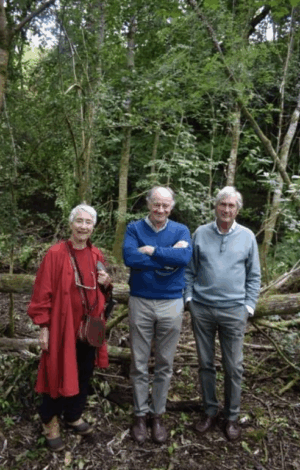
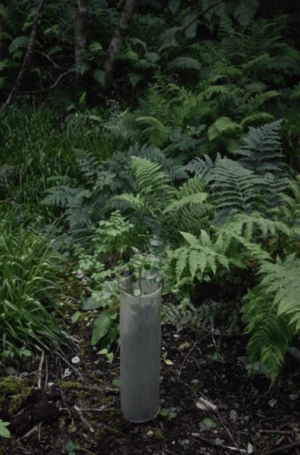
Afterwards, we visited the Scottish Association for Marine Science (SAMS) in Oban, where I was pulled into one of the most unexpectedly curious corners of the trip—Scotland’s red snow. We met with Dr. Alex Innes Thomson and Dr. Matthew Davey of Scottish Association for Marine Science (SAMS), who are leading the first systematic study of snow algae in Scotland. Thanks to a grant from HIEF, this project is mapping snow algal blooms in the Scottish mountains and raising awareness among summer hikers. By analysing samples and historical records, the team aims to understand the distribution and diversity of snow algae across Scotland.
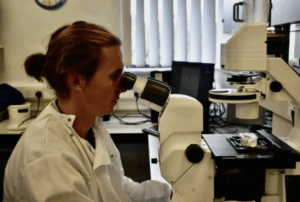
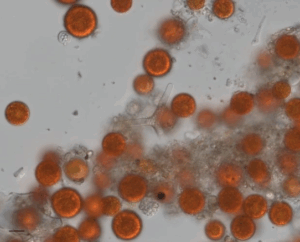
From the moment Alex and Matthew began to speak, it was clear: this wasn’t just fieldwork—it was a passion project. They talked about red snow with such vivid language and excitement that the science felt more like poetry. These red snow algae— Sanguina nivaloides and others— bloom only under a very specific “goldilocks” condition of slushy, just-right snow and contain the same pigment that gives salmon their pink colour. While red snow has long been studied in Antarctica and the Rockies, it has remained a mystery in Scotland since the last recorded study in the 1960s. Until now.
As they showed us photos in a presentation and samples under the microscope—a dazzling constellation of red cells. Alex described a snow tunnel stained with red as “like a raspberry ripple Sistine Chapel.” He likened this phenomenon as “bioluminescence for snow”—fleeting, beautiful, and mysterious.
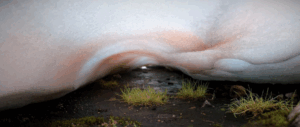
But behind the beauty lies urgency. Of the 11 years with total snow patch loss in the past century, 9 have happened in just the last 20. With projections of little to no snow by 2080, entire micro-ecosystems—algae, snow mites, tardigrades—could disappear. These tiny organisms help regulate carbon and snow reflectivity, yet most people don’t even know they exist.
The team is not only sampling and mapping these blooms, they’re biobanking the algae for future study. Who knows what secrets they may hold? Some red algae species have shown promise in reducing methane emissions from livestock or investigated for their potential medical applications. Perhaps, one day, the cells found in a Scottish snow patch could play a role in climate mitigation or treat diseases.
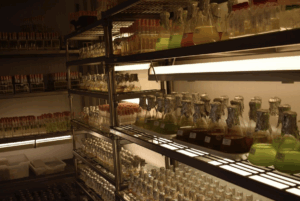
Their outreach campaign is also growing, with support from groups like RSPB and the National Trust for Scotland, and public contributions of photographs.
What struck me most was this blend of mystery, urgency, and possibility. Conservation isn’t just about what we know—it’s about protecting what we’ve barely begun to understand. And sometimes, the tiniest things—overlooked and half-melted by morning—can teach us the most.
So if you’re hiking in the Scottish hills this summer and see a patch of snow streaked like raspberry ripple – snap a photo and send it to ecosnow@sams.ac.uk or log it on the Living Snow Project app.
Reflections
From rainforests slowly healing to the quiet mystery of red snow algae blooming in the mountains, this trip was a powerful reminder of how much beauty and significance lies in what’s often overlooked.
Thanks to the support of HIEF, projects run by the likes of Keep Oban Beautiful and the Scottish Association for Marine Science are doing more than restoring ecosystems—they’re rekindling curiosity and inspiring care for the natural world.
Here’s to wild swims, red snow, and the quiet return of wildness.
— Sekoah
